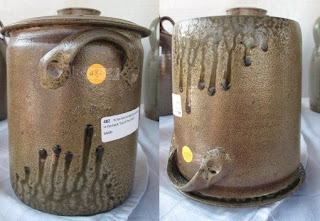 |
| This fascinating array of objects were nearly all from the Westerwald region of Germany, it was such a pretty sight to see! |
I know, you're probably thinking, "what in the world is so attractive about that?!" Well, there are numerous aspects, really. This likely 19th or early 20th century salt-glazed stoneware bottle had a great handle for starters. Then, it had such great distinctions for how it was fired. Look at how the neck is cocked to one side, and then in the photo below at the narrowing on the sides. This tells me that this piece was single fired, and shows these deformations because of the weight and stress of stacking (no shelves used) and the movement of the clay body as it came to temperature during the firing.
And the top of the bottle also showed some great signs of firing:
 |
| This bottle's collar likely covered the rim of the bottle judging from the mark in the left photo, and also touched on the shoulder of the bottle as seen by the marks in the photo on the right |
UPSIDE DOWN! You can see the wonderful dripping action on the side of the piece, and the pooling of ash on the underside of the handles and rim. Below, you can see how the piece was also likely at the top of the kiln, or between other objects, as it had nothing placed on its base, leaving a beautiful textured surface. You can also see in the photo on the left (below) a likely small chunk of kiln debris which has been there for almost 200 years!





2 comments:
Nicholas Fox is my husband's great-great-great grandfather and we just were at the North Carolina Pottery Center yesterday and saw one of his jugs in their museum. It was beautiful. Thank you for posting the pictures of his work here. Do you happen to know of a biography that has been written about him?
Thanks so much! I am enjoying your blog!
Sorry for not getting back to you right away! That's very exciting to have such a gifted ancestor! I do not know of a biography on him specifically, but The Potter's Eye by Mark Hewitt and Nancy Sweezy has the piece I showed pictures of and some biographical information. If you ever find something more specific, do let me know! Next time you are in the area, check out Sherry's Restaurant in Ramseur. They have quite a few pieces of Fox's in their little displays throughout the restaurant!
Post a Comment